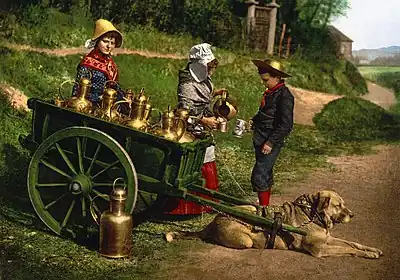Dogcart (dog-drawn)
A dogcart is a cart pulled by one or more drafting dogs.


Description
Dog carts pulled by two or more dogs were historically used in Belgium and the Netherlands for delivering milk, bread, and other trades.[1] In early Victorian Britain, dogcarts were associated with bakers, and when they used the area reserved for pedestrians, were considered a nuisance.[2] Dog-drawn carts were prohibited in London in 1840, but some still exist (mainly for reasons of novelty) in France and Belgium for delivering churns of milk from small farms to the dairy.
LVI – Dog Carts, &c. prohibited after 1st January 1840.
- And be it enacted, That after the First Day of January next every Person who within the Metropolitan Police District shall use any Dog for the Purpose of drawing or helping to draw any Cart, Carriage, Truck, or Barrow shall be liable to a Penalty not more than Forty Shillings for the First Offence, and not more than Five Pounds for the Second or any following Offence.
— Metropolitan Police Act 1839, section 56; repealed by Statute Law (Repeals) Act 1973]
Carts pulled by a single dog were sometimes used by peddlers. Dogs were used as draught animals during the World War I to pull small field guns. Dogs were used by the Soviet Army in World War II to pull carts containing a stretcher for wounded soldiers.
The modern-day sport of carting is an entertainment involving large dogs pulling carts. Compare dog sled, in which a team of dogs pull over snow or ice.
See also
References
- Dogcarts & Lioncarts. The Messybeast.
- Robinson, William (1842). The History and Antiquities of the Parish of Stoke Newington in the County of Middlesex: Containing an Account of the Prebendal Manor, the Church, Charities, Schools, Meeting Houses, &c., with Appendices . p. 18. Retrieved 29 March 2016.